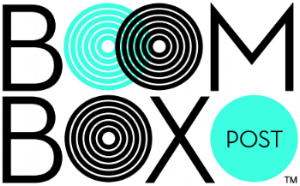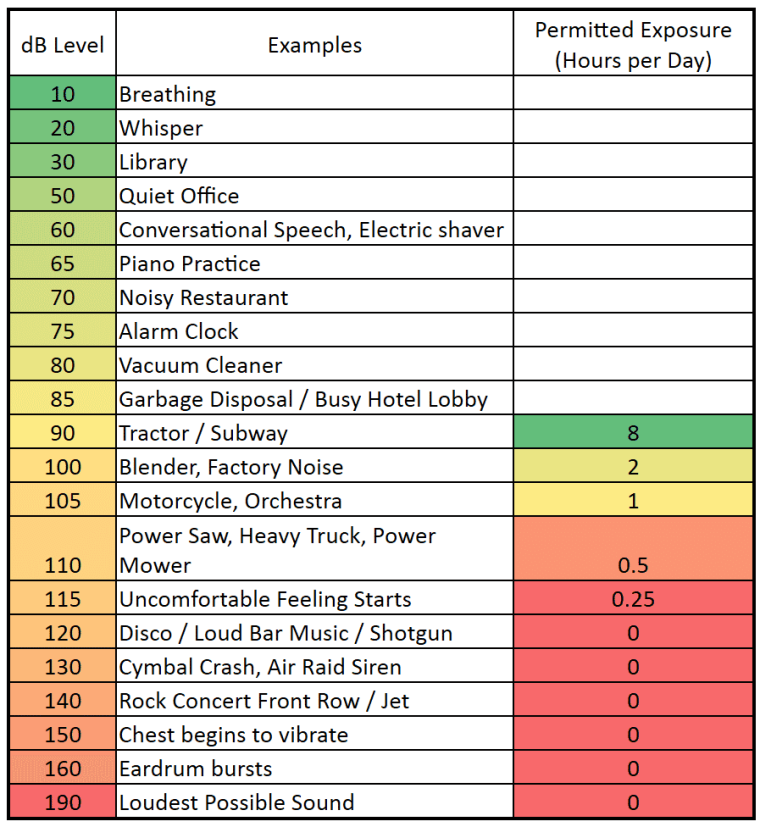As sound professionals, our most important tool isn’t a plugin or piece of gear, it’s our ability to hear. You’d never trust a mix on broken studio monitors or faulty headphones, so it makes no sense to overlook the health of your own ears! In this post I’d like to discuss our ears and how to care for them to ensure a long and prolific career in audio post.
The Human Ear
Frequency Range
Healthy young adults can hear approximately from 20 Hz (deep bass) up to 20 kHz (ultra high-end treble). Check out this fun chart to see the hearing range of common animals! Our ability to hear the highest frequencies naturally fades with age, often beginning in our late 20s or early 30s. By middle age, it’s common for many people to top out around 14–16 kHz, even with no signs of hearing loss.
Dynamic Range
Beyond frequency range, the human ear is also incredibly sensitive to changes in loudness or sound pressure level (SPL). In ideal conditions, a healthy human ear can detect sounds as quiet as 0 dB SPL, which is equivalent to a mosquito flying 10 feet away, or the sound of your own heartbeat in a silent room. Our ears can perceive sounds across a dynamic range of over 120 dB. For context, normal conversation is about 60 dB, while the limit of pain begins around 120–130 dB.
The same sensitivity that allows us to detect the full frequency spectrum of sound also makes our ears vulnerable. Just as they can detect the sound of our own heartbeat, they can also be damaged by extended exposure to louder sounds, especially without any physical warning signs. We often don’t feel the damage being done until it’s too late. As audio professionals that rely on our ears for the quality of our work, it’s absolutely crucial that we protect them as best we can for the sake of our the longevity of our careers.
So How Loud Is Too Loud?
First, How does hearing loss actually occur? Hearing loss from noise exposure doesn’t usually come from one loud moment: it’s actually a slow, cumulative process. Every time you're exposed to sound above safe SPL levels, tiny sensory hair cells in your inner ear (specifically, in the cochlea) take on stress. Over time, those cells stop responding to sound. Unlike other cells in your body, they do not regenerate.
Even if you’re not experiencing immediate symptoms, that gradual wear accumulates until one day you realize that certain frequencies have dulled, or you begin hearing a persistent high-pitched ringing (aka tinnitus). In other words: hearing damage is permanent, and it’s usually silent until it’s not.
This is why safe listening practices shouldn’t only be reserved for your studio environment… but anywhere and everywhere you’re exposed to unsafe SPL levels over time.
Safe Studio Work Conditions
As audio professionals, we work in environments that are intentionally loud (especially if you’re cutting sound effects on a show like Invincible). Obviously our headphones and studio monitors are key for us to complete our work accurately and efficiently, but when we’re spending 8+ hours a day exposed to elevated SPL levels, it’s crucial to be sure these levels fall within a safe range.
Standard calibration levels for mixing and editing vary depending on room size and format:
For theatrical mixing on larger mix stages, ~85 dB SPL (C-weighted) is industry standard.
For nearfield studio environments such as smaller edit rooms and home studios, 79–82 dB SPL is the commonly recommended level.
These levels are typically measured using -20 dBFS pink noise, played through the full monitoring system. Benni Knop from Noisy Post has a great tutorial video on how to calibrate your room in the studio or at home. Also worth checking out: this livestream recording from Thomas Boykin where he goes more in-depth about calibration and room acoustics.
While these reference levels are essential for accuracy, they sit right near the threshold of what’s considered safe for long-term listening. According to NIOSH guidelines, 85 dB SPL is the maximum safe level for 8 continuous hours. Every 3 dB above that halves the safe exposure time.
Remember, hearing loss is caused by cumulative exposure. It’s not about one loud event or incident. It’s about every day, and how they all add up over the course of your career. While we must be conscious of SPL levels in our studio, we must also consider potential everyday life risk factors. Here are some common activities that can exceed the safe noise levels:
Vacuum Cleaner: 70-90 dB SPL. Safe exposure limit: up to 2 hours
Hair Dryer or Blender: ~94 dB SPL. Safe exposure limit: ~1 hour
Gas powered lawn mowers, leaf blowers: 90-100 dB SPL. Safe exposure limit: 30min to 2 hours
Shop Vacs and Power Tools: 100-110 dB SPL. Safe exposure limit: <15 minutes
Concerts & Music Festivals: 100-110dB SPL (depending on distance from speakers). Safe exposure limit: <15 minutes
Below is a chart I’ve found with some additional examples of everyday noise makers.
Hearing Protection for Pros
When it’s impossible to control the SPL level of the environment you’re in, such as it is for concert goers and musicians: it’s imperative to protect your ears. We’re all familiar with the big foam earplugs as well as the over-ear ear muffs. This form of protection is bulky, uncomfortable and worst of all: completely muffles the sound. I don’t think I’m alone in saying that these “solutions” just don’t cut it for concerts or loud events as they ruin the sound and inhibit social interactions. Flat-attenuation or high fidelity earplugs let you hear music and human voices accurately, just quieter. Here are a list of some earplugs I’ve used for concerts and events as well as around the house
Earasers: Designed for pros: comfortable, durable, and tuned for flat attenuation across frequencies.
Etymotic: Affordable, quality alternative with linear filter design.
Custom-molded plugs: Best comfort and acoustic performance, ideal for serious use. Check out brands like Westone or Etymotic. This option is the most expensive and the buying process is more involved as you must get the impression of your ear by an audiologist, but it’s well worth the investment for musicians and frequent concertgoers that rely on their ears for their career.
Why It Matters to US as Audio Professionals
As sound people, we’re exposed to more sound than the average person. And our work depends on fine-tuned, accurate hearing. That makes protection not just a good idea, it makes it a professional responsibility. High-frequency hearing accuracy is crucial in our work! Hearing loss—especially in the higher frequency range—can result in unbalanced mixes: dialogue that’s overly sibilant, overly bright music cues, or overly boosted highs that sound harsh to others. You might miss subtle clipping, noise artifacts, or tonal shifts entirely. In a field where precision is everything, the slow creep of hearing loss can compromise the very quality and consistency that clients expect. Preserving your hearing isn’t just about long-term health, it's about protecting your ability to deliver great work, day after day, year after year.
If you enjoyed this blog, check out these:
HOW DO OUR EARS WORK
LUNCH AND LEARN: SOUNDGYM
LUSH SOUND DESIGN: USING FREQUENCY PERCEPTION AS A TOOL


